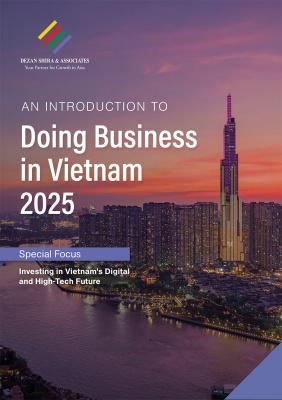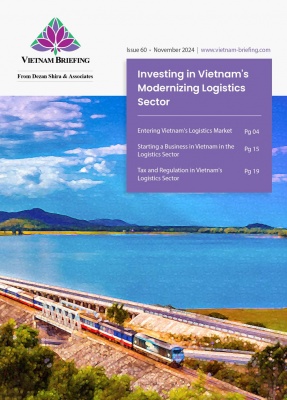Vietnam’s Booming ICT Market Expands Opportunities for Foreign Investment
Vietnam’s information and communication technology (ICT) industry is experiencing rapid growth and offers vast potential for further development. As one of the fastest-growing economies in Southeast Asia, the country is poised to become a leading player in digital transformation, driven by increasing demand for advanced ICT infrastructure. With significant investments in sectors such as artificial intelligence, cloud computing, data centers, and blockchain, Vietnam is positioning itself as an attractive destination for both local and international investors.
The demand for ICT infrastructure is set to continue rising, fueled by growing internet penetration, increased digitalization across various industries, and strong government policies that support technological innovation. This dynamic landscape presents ample opportunities for foreign companies to engage with Vietnam’s expanding ICT ecosystem and contribute to its ongoing development, which is projected to play a key role in shaping the country’s future economic growth.
Revenue and market size of Vietnam’s ICT industry
Vietnam’s ICT market is emerging as a major driver of economic growth, innovation, and employment. According to the Ministry of Information and Communications (MIC), the total revenue of Vietnam’s ICT industry in 2024 reached an estimated VND 4,244 trillion (US$165.9 billion), an increase of 13.2 percent from 2023. This revenue contributed an estimated VND 109.5 trillion (US$4.3 billion) to the state budget, an increase of 15.1 percent from 2023, and around VND 989 trillion (US$38.7 billion) to the country’s GDP, up 11.2 percent year-on-year.
The total number of employees in the ICT industry is estimated to be in excess of 1.5 million, an increase of 2 percent compared to 2023.
Per the MIC, Vietnam is currently home to over 27,600 ICT companies, including around 4,500 hardware companies employing over 900,000 people, 12,500 software firms employing 224,000 people, and 9,700 IT service providers employing 84,000 people.
The industry is also expected to see significant growth over the next decade, with market projections ranging from US$14.64 billion in 2030 (Mordor Intelligence) to US$40.3 billion by 2033 (IMARC Group). According to market research firm IMARC Group, Vietnam’s ICT market size reached US$11.4 billion in 2024.
Meanwhile, a report from the Vietnam Software & IT Services Association (VINASA) released in late February cited by media reports projects Vietnam’s ICT industry to generate up to US$170 billion in revenue in 2025, contributing over 12 per cent to the annual GDP.
Key drivers of Vietnam’s ICT industry growth
The boom of Vietnam’s ICT industry has been largely driven by increased domestic demand for IT services (driven by increased internet penetration), beneficial government policies, and large levels of investment.
In terms of demand, internet adoption and digitization continue to increase in Vietnam. According to DataReportal, which maps global digital adoption and use, Vietnam had 79.8 million internet users at the beginning of 2025 and an overall internet penetration rate of 78.8 percent. By comparison, the online penetration rate in South Korea reached 97.4 percent at the beginning of 2025, suggesting that there is still significant room for internet usage to grow in Vietnam. According to an analysis by advisory firm Kepios, cited by DataReportal, there were 223,000 more internet users in January 2025 than a year earlier, an increase of around 0.3 percent.
The adoption of digital technologies among private businesses is also on the rise. According to a survey by CPA Australia, 74 percent of respondents in Vietnam reported having a digital strategy—significantly higher than the Asia-Pacific average of 63 percent. Additionally, nearly 80 percent of Vietnamese respondents stated that they had used AI in the past 12 months, compared to 69 percent in other surveyed markets.
Similarly, a survey conducted by Acclime in partnership with Singapore’s United Overseas Bank (UOB) found that 87 percent of the 525 respondents were integrating digitalization into their businesses. Moreover, eight in 10 respondents indicated plans to increase their digitalization budgets by 10 to 25 percent in 2024.
While there is little data showing the change in the digitalization rate of public services, a report from the MIC on Vietnam’s national digital transformation released in August 2024 revealed that 55.5 percent of public services were being provided online as of that date.
The Vietnamese government has also been seeking to drive digitalization of both private and public industries through initiatives, such as the National Digital Transformation Program (NDTP), launched in 2020, and the Information and Communication Infrastructure Master Plan for the Period 2021-2030, with a Vision to 2050 (the Master Plan), launched in March 2024.
The Master Plan sets various targets for the development of Vietnam’s internet and communication infrastructure by the years 2025 and 2030, including (but not limited to):
- 100 percent of households to have access to fiber optic cable by 2025;
- 90 percent of households to have access to fixed internet with an average speed of 200 megabits per second by 2025;
- Mobile broadband to have an average download speed of 40 megabits per second for 4G networks and 100 megabits per second for 5G networks;
- 100 percent of the adult population to have a smartphone by 2025;
- The fixed broadband network to offer 100 percent of users access at speeds above one gigabit per second by 2030;
- For 5G mobile broadband network coverage to reach 99 percent of the population by 2030; and
- Adding four to six more international undersea fiber optic cables by 2030.
Another key policy initiative is the Digital Infrastructure Strategy, which focuses on expanding 5G coverage nationwide, enhancing data infrastructure, integrating IoT, and improving digital services. By 2030, the country aims to achieve 99 percent 5G coverage, deploy six new undersea fiber optic cables, and establish advanced, AI-ready, and environmentally sustainable data centers.
The strategy also seeks to increase IoT adoption, with four connections per person, and boost digital signature usage among adults to 70 percent. Smart solutions will be implemented across key sectors, such as transportation, healthcare, education, and manufacturing, to drive economic growth. Ultimately, Vietnam aims to rank among the top 50 globally and third in the ASEAN region in e-government and the digital economy, solidifying its position as a regional leader in digital transformation. In 2024, Vietnam ranked 71st in the UN’s e-government ranking, an improvement of 15 places from 2022, and fifth among ASEAN nations.
Major investments in Vietnam’s ICT industry
Vietnam’s ICT industry has witnessed a significant surge in investment, with a shift from lower-value manufacturing to higher-value, technology-driven sectors. Foreign companies are playing a major role in this transformation, investing heavily in areas such as artificial intelligence, big data, blockchain, and cloud computing. These investments, often made in partnership with local players and alongside domestic initiatives, are positioning Vietnam as a regional hub for digital transformation.
Telecom and 5G expansion
Vietnam’s telecommunications sector is experiencing substantial investment, particularly in 5G technology. Companies like Viettel and VNPT, the country’s leading state-owned telecom companies, are actively deploying 5G infrastructure, supported by government incentives such as a 15 percent subsidy on equipment costs. Viettel has launched the world’s first commercial Open RAN (O-RAN) 5G network in collaboration with the American semiconductor and software company Qualcomm, with plans to expand deployment beyond 300 sites by the first quarter of 2025.
Meanwhile, VNPT has partnered with the Swedish telecom giant Ericsson to implement energy-efficient 5G technology in Vietnam’s major cities, catering to dense tourism and industrial areas. The government’s commitment to expanding 5G networks through financial incentives and undersea cable investments ensures rapid digital transformation.
Blockchain development
Blockchain technology is gaining traction in Vietnam, with the government actively promoting its integration into key industries. In January 2025, Vietnamese technology company One Mount Group committed between US$200 million and US$500 million to developing a “Make in Vietnam” Layer 1 blockchain network, emphasizing high-speed transactions, scalability, and security. This initiative aims to facilitate decentralized applications (DApps) across finance, healthcare, education, and public services. Backed by the MIC, the Vietnam Blockchain Association, and government directives, this blockchain investment is set to propel Vietnam’s digital economy forward and establish the country as a dominant force in blockchain innovation within Southeast Asia.
Cloud computing
In 2023, Microsoft Vietnam and Viettel signed a strategic cooperation agreement to promote Industry 4.0 solutions, including cloud computing, data analytics, and AI, across multiple sectors. Under this partnership, Viettel Cloud will be integrated with Microsoft Azure, enabling localized Microsoft applications and expanding cloud services within Vietnam.
For Microsoft, collaborating with Viettel provides access to domestic data center infrastructure and a deeper understanding of Vietnam’s market needs. This partnership also facilitates the deployment of Azure Cloud solutions tailored for public administration, AI-powered services such as Azure Machine Learning and Azure OpenAI, and applications in speech technology and ChatGPT.
Meanwhile, Amazon Web Services (AWS) has also announced it will launch its AWS Local Zone, a smaller version of its data center services, in Vietnam, reinforcing its long-term commitment to the country’s digital transformation. AWS’s Local Zone infrastructure would bring cloud computing, storage, databases, and AI-powered solutions closer to businesses, reducing latency for critical applications.
Data centers
Vietnam’s data center industry is experiencing rapid growth, spurred by the increasing demand for infrastructure to support emerging technologies such as AI, big data, and cloud computing. Domestic tech companies, including VNPT, Viettel, CMC, FPT, and VNG, are heavily investing in expanding their data center operations. CMC, the country’s second-largest tech firm, is set to invest up to US$500 million in data centers by 2028 across various Asian markets, including Vietnam.
Viettel is also making substantial strides in the sector, planning the development of 11 large-scale data centers with a combined capacity of over 350 MW – representing 40 percent of the country’s total data center capacity, according to the MIC. The company is also collaborating with NVIDIA to create AI-focused data center infrastructure, featuring nearly 800 supercomputers and 6,000 GPU cards.
Several multinational tech giants are also entering the Vietnam data center market. The Chinese technology and e-commerce company Alibaba is reportedly planning to build a data center in Vietnam to comply with local data storage laws, while ST Telemedia Global Data Centre, a Singaporean data center provider, in March 2024 announced a joint venture with VNG Corporation to build and operate a data center in Ho Chi Minh City.
Google is reportedly also planning to build a large data center in Vietnam, in what would be the first such data center built by a US company. However, plans are yet to be confirmed by the company.
Artificial intelligence
Vietnam is becoming a significant player in AI innovation, with major global tech firms investing heavily in the sector. The American technology company NVIDIA has partnered with the Ministry of Planning and Investment to establish AI research and data centers, reinforcing Vietnam’s position as an AI hub. NVIDIA’s acquisition of VinBrain, a Vietnamese healthtech solutions company, highlights the growing interest in AI-driven healthcare solutions.
Furthermore, NVIDIA’s partnership with FPT Corporation, a Vietnamese IT services company, has led to a US$200 million investment in an AI factory, expected to be fully operational by 2025.
To encourage AI and semiconductor research, Vietnam has introduced financial incentives through the Investment Support Fund. Under this initiative, companies investing at least US$117.9 million in R&D projects may receive up to 50 percent funding for eligible costs. This policy aims to attract more high-tech investments and accelerate Vietnam’s digital transformation.
Tapping into Vietnam’s ICT market opportunities
Vietnam’s rapidly growing ICT market presents significant opportunities for foreign investors looking to tap into the country’s expanding digital landscape. With increasing demand for advanced infrastructure, especially in areas like artificial intelligence, cloud computing, and data centers, the potential for growth is substantial. Furthermore, the Vietnamese government’s supportive policies are designed to attract investment and accelerate technological advancements.
Foreign companies have the chance to collaborate with local players, leverage government-backed initiatives, and contribute to shaping Vietnam into a regional hub for digital innovation, making it an ideal time to invest in the country’s thriving ICT sector.
About Us
Vietnam Briefing is published by Asia Briefing, a subsidiary of Dezan Shira & Associates. We produce material for foreign investors throughout Asia, including ASEAN, China, and India. For editorial matters, contact us here and for a complimentary subscription to our products, please click here. For assistance with investments into Vietnam, please contact us at vietnam@dezshira.com or visit us at www.dezshira.com.
Dezan Shira & Associates assists foreign investors throughout Asia from offices across the world, including in Hanoi, Ho Chi Minh City, and Da Nang. We also maintain offices or have alliance partners assisting foreign investors in China, Hong Kong SAR, Dubai (UAE), Indonesia, Singapore, Philippines, Malaysia, Thailand, Bangladesh, Italy, Germany, the United States, and Australia.
- Previous Article Opportunities Amid Tariff Risks: Vietnam Aims for Trade Balance with the US
- Next Article China’s Manufacturing Presence in Vietnam: Locations and Future Growth
































